Domaine des Terres Dorées / Jean-Paul Brun
I have loved Brun’s wines from the first time I tasted them. So the first thing we did after our plane landed in Lyon was to rent a car and drive to Charnay. I have sometimes heard Brun’s wines criticized for being unpleasantly lean. I can understand the adjective but not the adverb - I think leanness can be a very positive aspect of wine.

One possible reason that Brun’s wines come across as lean and structured rather than sweet and easy and fruity is that he vinifies the wines in a Burgundian manner instead of with carbonic maceration. “Concrete rocks!” is something I can imagine Brun saying. He didn’t use quite such words but he did become quite animated when talking about the benefits of concrete as opposed to inox. I wish I understood the winemaking process better but I’ve always found the most enjoyable part of wine to be drinking it, preferably with a plate of something unhealthy and fatty on the table before me and so I’ve never paid as much attention as I should have to the technical side, but apparently concrete lets in oxygen which is somehow beneficial. Perhaps someone here can explain?

Brun explaining to Arto Koskelo why concrete rocks!
Anyway, after a quick tour through the cave, we had a tasting of practically everything that Brun makes:
Roussanne 2010 - nice, little bit neutral aromas, something strangely herbal going on on the nose; lovely freshness for the grape. Charnay is, says Brun, the absolute northern limit where Roussanne can be grown which, he thinks, explains why it is so fresh and light for the grape.
Chardonnay Classic 2011 – a pure, unwooded, nicely appley style; rich compared to the 2010 that I go out of my way to find excuses to open, but also fun though in a less racy style. But less racy in Brunian terms still means pretty racy in general terms.
Beaujolais Blanc Vinification Bourguignonne 2011 – obvious oak aromas on the nose, but not too much, I suspect, for most; good crunch and richness. I preferred the Classic.
Cuvée Première 2012 – young vine Gamay: a fun, peppery, almost Syrah-smelling wine but with all the lean joy and purity I’ve come to expect from Brun.
L’Ancien 2012 – everyone was talking about how 2012 was such a difficult year. It may have been, but the wines everyone presented ranged from perfectly fine to just lovely. Production may have been only 30-50% of normal, but quality seems to be good if you like a leaner, less sexy/fruity style, and many producers likened it to 2008 and/or 2010. L’Ancien was its usual wonderful self: lean but pure and very moreish. Perhaps not quite as ethereal and pretty as the 2010 but I liked it very much.
Côte de Brouilly 2011 – a richer year than 2012 and everyone, including Brun, spoke of it as a good or even great year. This had an open aroma, quite spicy and bit Syrah-like; quite rich for a Brun. Great stuff and the only cru that was kind of open. I liked this very much though it was a bit different from my previous experiences of Brun.
Morgon 2011 – more tannic than the CdBrouilly, but very good. It’s grumpy now so it’s difficult to say anything about it except that it seems very true to Brun’s style and all the pieces seem to be in good places for this to hopefully become something nice in a couple years. Hold.
Fleurie 2011 – exquisitely pretty; perfect balance though a rich year for Brun. I often seem to like Fleurie more than the other crus (and not just with Brun but in general). This is painfully young though it has ripe fruit, but it has already developed hints of the perfumed, peachy aromas that Fleurie can sometimes have. I shouldn’t really enjoy a painfully young wine as much as I enjoyed this. But I guess in some instances everyone can have slight masochistic tendencies.
Moulin-à-Vent 2011 – again a quite tannic wine akin to the Morgon, but I seem to have a bit of trouble with M-a-V: for some reason, I rarely find them charming (though wait until I write up my Yvon Métras notes, since there I finally found a superb example!). So it’s perfectly nice, but still my least favourite of the Brun Crus.
Pinot Noir 2012 – a wonderful cherry aroma; very pure, light but intense and savoury and I really loved it. Fresh and palate cleansing – only open with people who appreciate structured Pinot.
Charme Blanc de Blancs (2010 though officially NV) – quite a sweet aroma though a 100% Chardonnay extra brut bubbly; good richness and great bite, this isn’t a harsh style of extra brut. I thought it was very enjoyable.
FRV 100 – a Methode ancestrale bubbly - 30 g/l RS and 7,5% abv. Some might say it is just a sweet, simple bubbly but I thought – as with Brun’s whole range – that it transcends all that one imagines from such sobriquets. Sweet, yes, but also with a nice acidic bite; simple and fruit-forward, yes, but also one that somehow invites me to become reacquainted with it. My first bottle, that I drank several years ago, I thought was ok but nothing interesting. Somehow, I still kept on buying it whenever I could and now it is one of my favourite bubblies.
We stayed the night at Les Hauts de Chénas, a little B&B type of place near the top of the Chénas hill – the views over Chénas were pretty amazing.

They have a nice little restaurant were they make perfectly decent local foods. And the owner, Nathalie Fauvin, also makes some attractive wine. She is one of the few female winemakers in Beaujolais (though more have started making wine in recent years) and she made her first vintage in 2001 after inheriting the property. Her father used to make just one wine, simply labeled Chénas, but Nathalie has expanded the range slightly.
Domaine des Brureaux
Chénas Cuvée Coccinelle 2011 – Fauvin was almost as keen on praising concrete as Brun! She likes the way that e.g. tartarates left on the cement give a continuity to the style year to year and she also appreciated the oxidation and feels that it provides better results than the completely sealed environment of inox. This was a pretty wine made from “young” vines of c.20yo, it is bright and fresh with the ripeness of 2011 showing, but it still has enough acidity to make this moreish. This isn’t as exciting a wine as some others we tried this trip, but it was a perfectly decent Chénas.
Chénas Cuvée Tradition 2011 – this was a bigger, darker, more sweetly fruity wine than the young-vine Coccinelle and is made from older vines (35-50yo IIRC). A more serious style but still made in concrete instead of oak. Nice!
Cuvée Séléné 2011 – this was named after Fauvin’s daughter and bears the further name “Le Vin au Féminin”. But there’s nothing stereotypically feminine about this wine (and why does the human brain so often want to ascribe masculine or feminine traits to non-living objects?): it is aged in oak, but the oak is old so theoretically it shouldn’t interfere with the wine. Yet I still wasn’t so keen on this: I think I can smell a bit of oak, or at least something aromatically very like oak, and that detracted from my enjoyment because I am a very limited person and my sense of smell easily gets confused by such aromas that I’m not fond of. Anyway, not really a wine for me.
Chénas Cuvée Préstige 2011 – this is made from over 90yo vines which makes it superdense. This is matured completely in old oak barriques but somehow it still smells a bit of oak. It is very rugged, dense and I’d like to say masculine though I just complained about humans ascribing gender to non-living thing. One this is certain: this needs age. And when this young, I really can’t say if I will like it or not.
Cuvée Séléné 2009 – a very sweet and ripe aroma, I still think I smell a bit of chocolate and spice and all things not so nice; rich. On the basis of these two vintages of Séléné, I’m not a fan of this bottling.
Chénas Cuvée Tradition 2007 – We were the last people to finish eating at Les Hauts de Chénas so Fauvin came to our table to discuss the wines with us. We started talking about recent Beaujolais vintages and I mentioned that I’ve been quite fond of 2007s though they have not been universally praised. First, she explains that recent years have been very tough because there has been hail so often: her grandfather and father “never used to get hail,” she said, “but now I’ve had hail almost every year!” In 2004, 2006, 2007, 2008, 2011 and 2012 she has lost huge amounts of grapes because of hail so yields have been tiny. 2012 was especially bad and she made IIRC only about 30% of her normal amounts. She then disappears and comes back with this bottle. It is a nice, slightly leaner style wine, not as voluptuous as the 2011 but with a really attractive balance between ripeness of fruit and raciness of structure. Nice! Fauvin likes the style of 2007, too, but she was a bit amused that I like it since most of her customers – even the ones who ask for light wines – prefer the big, sweet, rich styles (like the Séléné and such years like 2009 and 2011).

Sonic boom -device at Brureaux to make hail disappear - pseuo-science is alive and well!
On our second day in Beaujolais we had a morning appointment with Christophe Pacalet. Christophe is Marcel Lapierre’s nephew and pupil and is Philippe Pacalet’s cousin. Pacalet’s is an interesting winery since much of what he makes is actually Beaujolais Nouveau (his BN is hugely popular in Japan; I fear I might have written the wrong number down since it seems so huge, but I wrote that about half of his total output is BN!) and much of his wines he sells in BiB – all of this despite making “natural” wine with no or minimal addition of sulphur. “I want to make wine in the way my grandfather made them,” he said. With the crucial difference that now the result isn’t occasionally vinegar but always good wine. If this was a representative sample of what he does, I think he was lying to us. He doesn’t make good wine; he makes stupendous wines that are right up there with Lapierre and Foillard.
Pacalet purchases grapes from growers and vinifies the wines himself. In a sense this isn’t your normal négociant business since, like Eric Texier, he buys grapes from the same growers every year and works closely with them.

Christophe Pacalet and Mélina Condy of Inter Beaujolais
Bourgogne Blanc 2012 – apple and cinnamon; wonderful “natural” style. Crunchy and I liked it even more than Brun’s Beaujolais Blanc!
Chiroubles 2012 – the highest altitude Cru, this was very pretty, very clear and very crunchy. Ridiculously drinkable. This wine shows no signs of it coming from a difficult vintage.
The we went down to the cellar to try barrel samples of 2012s not yet bottled: the Fleury was really pretty with a nice peachy aroma; the Côte de Brouilly was dark toned in fruit and quite burly; the Moulin-à-Vent was tannic and not easy to enjoy now. But what was clear of all of them was that, at least for Pacalet, the quality of wines in 2012 will be very good even though it was a difficult year with hail and frost and mildew and whatever else nature can throw at a vine grower. But economically it doesn’t look good for any grower since nature destroyed so much of the crop.
Then we climbed up from the cellar to taste some bottled wines.
Fleurie 2011 – rich, quite dark and sweet fruit. Wonderfully racy on the palate, very refreshing though with obviously ripe fruit. Pacalet told us that 2009-2011 have all been good or even great years. 2009 was sunny so the grapes ripened so that the sugars went up and the acids down; 2010 was classic in a good way; 2011 had a warm wind that shriveled the grapes leading to high sugars and high acidity.
Côte de Brouilly 2010 - lovely freshness, open and “natural” and well balanced in a quite burly way. This comes from, in Pacalet’s words “easy and unproblematic,” parcels from this ancient volcano.
Fleurie 2009 – peachy and ripe but still wonderfully fresh and crunchy. This is one of the few 2009s that I really love. Almost everyone else, including the winemakers we visited, praised the wines of this vintage even though they all admitted that it was atypical. This however was a wine that did taste to me of Gamay and was racy, refreshing, moreish and, from what little I understand of the terroirs of Beaujolais, also typical of Fleurie.
Moulin-à-Vent 2008 – a darker, more tannic and serious wine though still obviously a “natural”, beginning to drink well IMO though no hurry. Good though this is, I have to admit that I just don’t “get” Moulin-à-Vent. I will certainly not turn down a glass or three of this if someone opens it but I did prefer the other wines. But this is obviously just a personal quirk and should not be read as damning this wine with faint praise.
Chiroubles 2007 – Christophe said that this is at peak now and no point keeping further. It is wonderfully open and “natural” and clean and pure but there’s really no worry that it will all of a sudden drop off the cliff – this is still very vibrant. And yes, it is lovely and moreish.

The wines were all lovely and showed very clear differences between the Crus. So there’s one myth busted that I’ve sometimes believed in – that “natural” wines all taste a bit too similar and that differences of terroir and even grape become minimized because of the winemaking process.
Before lunch we drove up the ancient volcano of Côte de Brouilly. We drove past the south-facing plots from which Pacalet purchases his grapes and then stopped for a moment at St. Lager’s church. I’m not into bad beer, but the church was pretty and the views wonderful. The best Beaujolais seems to grow on old volcanoes (Côte de Brouilly, Morgon Côte dy Py…).

St. Lager
Then with Mélanie from Inter Beaujolais who kindly organized these winery visits for us and Christophe Pacalet, we went off to Pré du Plat for lunch where we were joined by Jean Bourgade of Inter Beaujolais. We had a lovely lunch. Pacalet bought a bottle of white Roc d’Anglade 2011 a Vin de Pays de Gard which had a pretty, “natural” aroma but was really quite rich though saved by good acidity on the finish. And we also opened a bottle of Domaine de Prion Moulin-à-Vent Cuvée Vieilles Vignes 2011 which a perfectly nice, ripe, spicy style. Pré du Plat is a lovely bistro in Cercié run by Emilie Pelletier(?) Sorry, too much info to digest on this visit so I’m not sure I remember her surname – which is terrible because of this: Her restaurant serves simple but delicious local foods and she has a superb list of Beaujolais wines. And she is a wonderful character, too. All the wine people in the area seem to eat lunch there and she knows everyone of them. And her memory is incredible: the first time we ate there I had to ask for slight modifications to the food since I become violently ill from lactose. The second time we went, she remembered that and told me that she’s told the kitchen so no need to worry. She really seems to care about the customers and is interested in them. She’s awesome. I want to move to Cercié just so I can eat there every day. If she can remember such a detail about a visitor who has only been to her restaurant once before, there should be no excuse for me having forgotten her last name. ![]()

The village of Fleurie
After this leisurely lunch we headed to Fleurie to visit Jean-Louis Dutraive at Domaine de la Grand’Cour. This was a property I hadn’t heard of before (thanks Mélina for suggesting that we visit here). They make “natural” wine without or with minimal SO2 additions. Their yields are usually low at around 35hl/ha and the vines are mostly 30-40yo but with quite a bit of 60-70yo vines, too.

Jean-Louis Dutraive
Fleurie Cuvée Vieilles Vignes Terroir Champagne 2012 – a really lovely, bright and crunchy, Fleurie. A “Pinot” aroma. These are some of the oldest vines Dutraive has, c.70 yo.
Brouilly Cuvée Vieilles Vignes 2011 – though most of Dutraive’s plots are in Fleurie, he has a bit in Brouilly as well. This is an open and lovely and “natural” wine in a rather darkly but sweetly fruity and peppery style. A “Syrah” style of Beaujolais.
Fleury Cuvée Vieilles Vignes 2010 – a really lovely, peachy aroma. f*ck me this is good. A “Beaujolais” style Beaujolais after those two wines that brought images of other places.
Fleurie Vieilles Vignes 2002 – it was great to try an older vintage: this was still wonderfully fragrant and sweetly fruity with perhaps the most gorgeous, peachy aromatics that I have tasted in any Fleurie. This didn’t have a label on it since it came from Dutraive’s own cellar. Unfortunately my French is terrible so I’m not sure if I understood correctly, but if I did this comes from old plots from the terroirs Champagne and Grand’Cour (as that’s not only the name of the property but also one of his plots). It is still so vibrant that I can imagine this can still be forgotten in a cellar – though there’s not much point in doing that since I can’t imagine what benefit there could be as it is pretty much a perfect wine now.
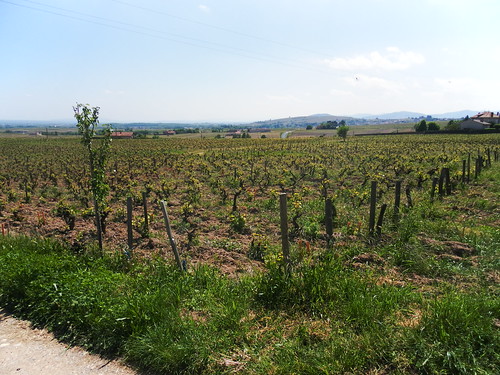
Dutraive’s vineyard
We met a group of young, promising winemakers over dinner. Mélina of Inter Beaujolais suggested we meet these people because she noted our interest in “natural” wine and several of these make bio or natural wine. All of these producers are much appreciated locally and some of these have already started exporting wine.
Domaine Claire & Fabien Chasselay

Fabien Chasselay
Beaujolais Blanc 2012 – nice acid for a wine that starts out gentle and ripe and fruit-forward. There’s a touch of oak here, too, which I’d prefer not to be there.
Beaujolais Rosé 2012 – light salmon pink, quite neutral aromas, ever so slightly earthy; nicely piercing acidity. Nice!
Beaujolais Quatre Saisons 2012 – this is their entry level Gamay: it smells a bit lactic on opening but turns into a peppery, “syrah”-styled Gamay with a bit of air. Very light and juicy and easy drinking. Not bad, but nothing to write home about.
Beaujolais Les Grands Eparcieux 2012 – was also a juicy, lighter styled wine with a spicy aroma. Again, not bad, but nothing special.
Fleurie La Chapelle des Bois 2011 – to put it mildly, this was a huge step up. It smells very seductive and peachy; it’s vinified in the Burgundian manner (i.e. not carbonic) and it even sees some new oak. Yet somehow the new oak aromas don’t emerge from behind the sexy Fleurie aromas. I’d like to try this in a non-tasting situation because often when enjoying wine at home I’ll find oak in a wine that I thought wasn’t tainted by it in a tasting situation. And I think Gamay is one of those grapes like Nebbiolo that simply can’t handle any new oak aromas at all.
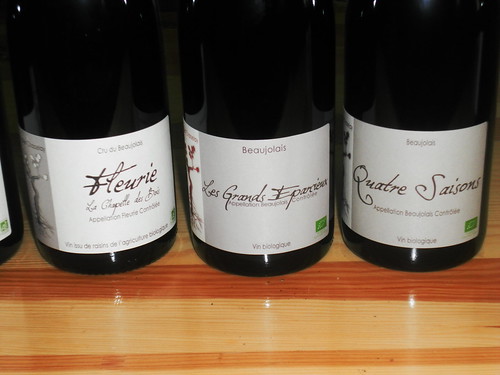
Chénas La Carrière 2011 – this is fermented in new oak barriques but aged in big old wood barrels. But still this smells more of oak than the Fleurie which is also aged in a small percentage of new barrique. The palate is better: the ripe vintage fruit is held in check by the racy acidity.
Côte de Brouilly L’Héronde 2010 – This is aged 15 months in old wooden tanks. Mr. Chasselay thinks L’Héronde is the best plot in Côte de Brouilly. It’s easy to understand his enthusiasm because this is wonderfully perfumed just like the Fleury; nice and crunchy style as expected from the year. Very attractive.
Bourgogne Pinot Noir 2010 – 18 months in new Vosges barriques. At first it smells more of Pinot than oak, but sadly quickly it turns the other way around.

Romain Jambon
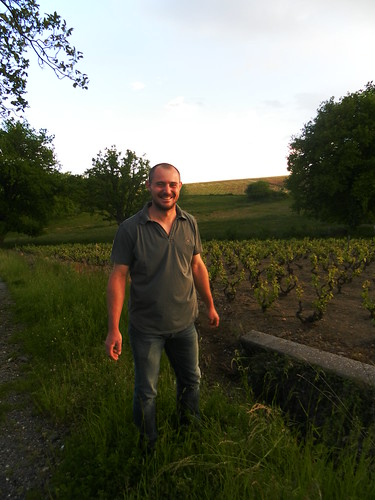
Jambon in front of Les Eronnes, Brouilly
Brouilly Les Eronnes 2012 – this is a non-carbonic, aged in tank instead of wood; from 30-50 yo vines. It is tight and tannic and is quite lean. I like the pieces but it is in pieces. Hold.
Brouilly Les Eronnes 2011 – wow! This is gorgeous! Very peachy; very fresh; quite high in tannins, too. Very attractive.
Brouilly Les Vieux Ceps 2011 – from 50-80 yo vines; aged 12 months in five times used barriques. The nose is almost smoky; it isn’t a very aromatic wine. But the palate is nice if you enjoy the Brun-style of slightly austere wine: tight, dense, tannic and with high acidity so the year’s strong fruit is not so forward as in most other 2011s we tried. I think this will turn out nice, but for now: hold!
Brouilly La Pointe des Einards 2011 – deep and dark aromas but it does have a welcome peachy perfume, too; great structure, fresh and crunchy acidity: it’s almost like biting into a ripe red apple. Very nice!

All in all, a very impressive range!
Domaine des Marrans
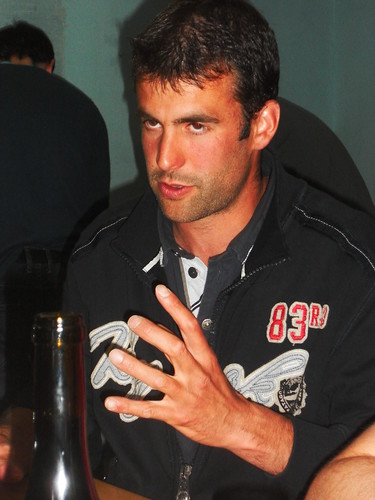
Mathieu Mélinand of Domaine des Marrans
Chiroubles Vieilles Vignes 2011 – semi-carbonic; it starts out smelling a bit reductive and plasticy but turns out ok after some vigorous swirling: peachy and juicy. Nice enough but IMO not quite on the level of some others this dinner.
Fleurie 2011 – a simple, juicy style with an attractive peach aroma; nothing wrong with this except that it just wasn’t terribly exciting.
Fleurie Terroir du Pavillion 2009 and 2011 – both were of a ripe style; but lacked some intensity. Ok, but outclassed.
Though to be frank, we did have an embarrassing amount of great wine open so I might have misjudged these Marrans. I need to try these again - they certainly were attractive enough that I am very willing to do so!
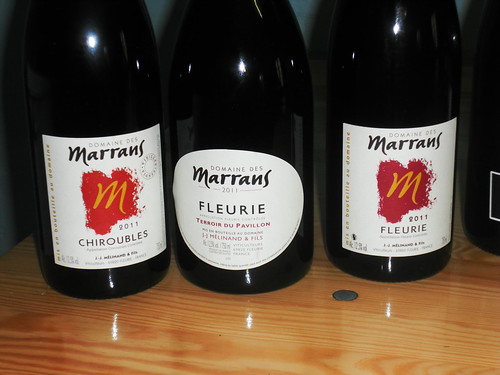
Domaine David-Beaupère

Louis-Clément David-Beaupère
Juliénas La Bottière 2012 – a deep, dense, masculine wine; powerful, tannic and very young wine made in a non-carbonic Burgundian style. Very promising but a bit brutish now. Hold.
Juliénas Claire David 2008 – this was L-C’s first vintage and made in a semi-carbonic style and aged in stainless steel. Very floral and aromatic; pleasantly light and mature. Attractive.

Julien Sunier
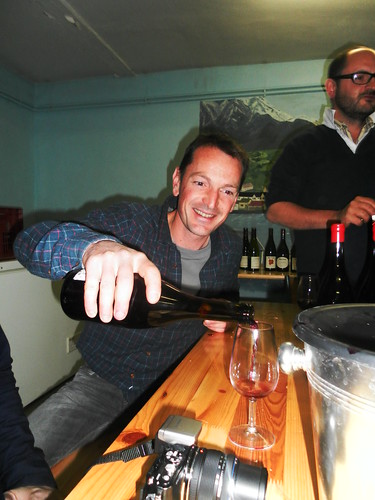
Julien Sunier
Régnié 2011 – Sunier’s plots are right next to Morgon Côte du Py. It is made with carbonic maceration and grillage (if I understood correctly, it’s a gentler form of pigeage since pigeage can be too tough for Gamay). A weird wine and I really need to try this again if I can find some because this is full of paradoxes: it is weightless in the mouth yet full of flavour; it is soft and textured more like cotton candy than wine; yet it is extremely lengthy and though I don’t want to use a word like intense for such an ethereal wine, I don’t know what else I could use! It tastes like there is nothing in your mouth when you drink it, yet it is at the same time the most flavourful drink imaginable. Certainly one of the most intriguing wines of the trip and I think it’s pretty damn good. Maybe even outstanding.
Morgon 2011 – this also has the Sunier paradox of weightlessness and full flavour. But it is a bit more tannic than the Régnié and with darker fruit aromas so it isn’t quite as ethereal. Great wine anyway.
Fleurie 2011 – I think Sunier might be a genius. Once again this has the lovely paradoxes I outlined above which make it hugely intriguing to drink. This Fleury also has nice gentle, floral, peachy aromas and is pretty soft yet with a persistent and refreshing finish (this comes from some of Fleuries higher plots at 470m altitude).

Paul-Henri Thillardon

P-H Thillardon
Chénas Les Carrières 2011 – a really fresh, aromatic Chénas; lively and moreish. Very nice.
Chénas Les Vibrations 2011 – a bizarre experiment with an 8 month maceration (yes, you read that right: eight months) – all the other winemakers joked that it’s good that Paul-Henri does such experiments so they won’t have to. It is deep and tannic but not too harsh. It’s interesting for sure, and it’s perfectly drinkable and actually really good. But I do have to wonder what the benefits of such a long maceration might be?

Domaine Chignard, Fleurie

Cédric Chignard
Before this trip I had only tried one Chignard, a 2009 IIRC, and I liked it very much. So I was keen to try more. Chignard’s vines are right on the border of Moulin-à-Vent – and since Moulin-à-Vent is generally considered the most tannic Cru, it might be a partial explanation as to why Chignard is a very well structured Fleurie. Chignard makes wines with the traditional semi-carbonic method. They have 8 ha of vines and IIRC, they make just two wines. Les Moriers is supposedly the basic wine except that it is exquisite and from 50-60 yo vines so it can hardly be called “basic”. The Cuvée Spéciale is made from 80-100 yo vines and is aged in barriques (with a five year rotation) as opposed to big barrels. The Spéciale needs lots of age, at least for one as oakophobic as myself. The 2007 only just seems drinkable.
Chignard Fleurie Les Moriers 2012 – a barrel sample. Everyone had talked of 2012 being a difficult year yet here again is a wine that doesn’t seem like it. This is really pretty, though it’s not a finished wine so perhaps there’s not much point talking about it, but it seems to have a great purity of fruit and good but not harsh structure.
Chignard Fleurie Les Moriers 2011 – this is quite an exquisite wine: perfumed and floral and peachy as I hope this cru to be; but it is also tannic (perhaps that’s the terroir close to Moulin-à-Vent?) and savoury and racy and palate-cleansing. Wonderful.
Chignard Fleurie Les Moriers 2010 – a lovely, crunchy style of wine, less ripe but more aromatic than the 2011; racy, elegant, structured but sexy. Lovely wine. The more I taste them, the more I love 2010s.
Chignard Fleurie Cuvée Spéciale 2010 – oaky, tannic, refreshing, and I didn’t like it. But then I tried a couple more vintages.
Chignard Fleurie Cuvée Spéciale 2009 – also oaky, and very sweetly fruity (hot year!). Tannic and un-charming at the moment. But the pieces seem like they might come together with a few years more age.
Chignard Fleurie Cuvée Spéciale 2007 - gosh! This really has magicked most of that oak away! This smells deep and savory and serious; but it is crunchy and lovable on the palate. I like it! This is just beginning to drink, so keep all the younger ones in the cellar still.
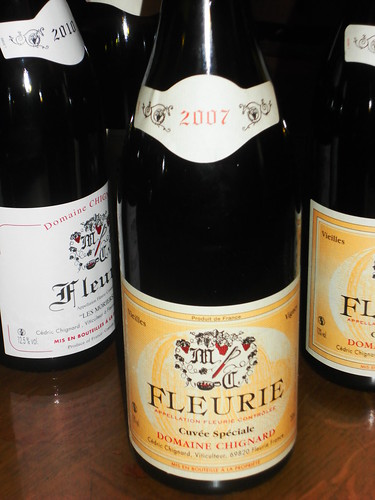
Jean Foillard
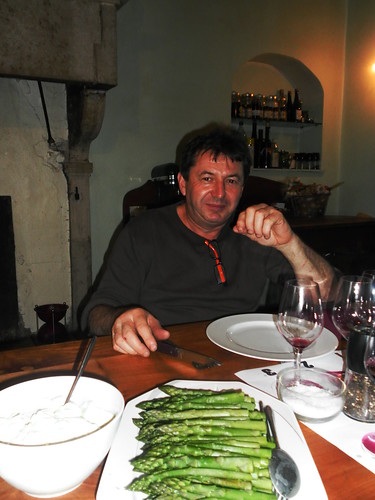
Foillard is a special property for me because it’s the first real Beaujolais that I tasted. Finland sucks, because we’ve got perhaps the worst alcohol monopoly in the world. I wish that Norway’s monopoly would run things here – that’s how bad it is. Anyway, in 2008-2009 I happened to be in London and I tried the first real Beaujolais I have had: it was Foillard. And I thought it was pretty awesome! Until that point I had only had the likes of Duboeuf. But the Foillard Côte du Py 2006 changed my mind. Now I understood why some people took Beaujolais seriously. It was just an exquisitely beautiful wine with lots of savouriness, and lots of ripeness, too. It seemed to have lots of everything yet it was also light and vivacious and savoury. The most memorable thing was how exquisitely fun it was to drink. Fun seems to be a word that is rarely mentioned when people write about wine which is a shame as it’s really the only reason to drink wine.
When we visited Foillard, he wanted to serve everything blind. He served his wines in several flights and he wanted us to tell him what we thought of them. This is a very good idea in theory, but there is one problem: my French is practically nonexistent, and Foillard claims his English is no better. (He lies!). I understood c.10% of what he said; but I think he understood about 98% of what I said.
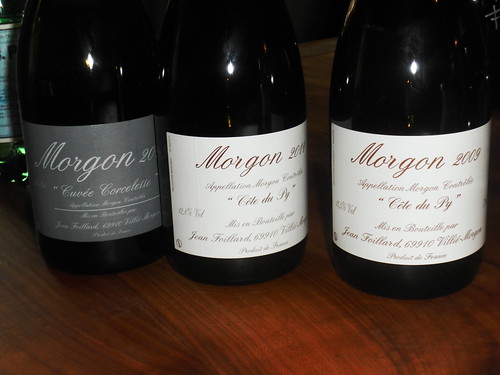
Morgon Côte du Py 2011
Perfect wine!? Bright and savoury. Foillard says that it is mineral but my thoughts are that it is all about the purity of fruit and frankly I can’t see anything mineral here. But that’s not a problem because the wine is supremely beautiful and savoury and crunchy despite the huge amount of ripe fruit. This is a big and sweet wine. But it is also a wine that I love despite my aversion to big and sweet wines generally.
Fleurie 2011
Sappy, fresh cherry fruit. Rich but racy. This seemed both lighter in colour and in fruit than the Côte du Py so I wondered, since these were served blind, if he had put a 2010 amidst 2011s to fool us. But no. Very pretty wine. This comes from La Madone and Grille Midi -parcels in Fleurie.
Morgon Corcelette 2011 – an old vine cuvée of c.50 yo vines; a dark and tannic wine that needs age but seems supremely pure. More monolithic and less vivacious than the Côte du Py.
Morgon Côte du Py 2010 – this was a really bright and lovely wine that smelled of strawberry juice. Sweet fruit but good crunchy acidity, too. Wonderful.
Fleurie 2010 – this is a difficult wine: the smell is perhaps the loveliest on the whole trip; but the taste does have a bit of CO2. Perhaps decanting would have helped. Anyway: unbelievably beautiful aroma.
Fleurie 2009 – Sweet and ripe, but it does have outstanding levels of acid for this notoriously low-acid year. I like it. And I think I think I’ll love it once the fruit calms down in future years.
Morgon Côte du Py 2009 – fresh and savoury for the year but not as refreshing as the Fleurie 2009.
Morgon Côte du Py Vieilles Vignes Cuvée 3,14 2009
Very sweet, very rich, raisiny, Foillard liked this but I thought it was a bit too much at the moment. Right now I preferred the more savoury 2010s. I don’t mind sweet fruit in a Beaujolais, but the level of sweetness here was uncommon in my experience of Beaujolais and felt more like that of Grenache, which I’m not usually so fond of. Hold. And hope that the fruit intensity diminishes.
After this tasting Jean Foillard’s wife Agnès cooked us lunch during which Foillard wanted to open a 2006 since he liked the fact his '06 was the first real Beaujolais I had drunk. So he went to his cellar and brought a Fleurie 2006. This was beautifully aged and intensely peachy in its aromas; it had turned quite light and soft and had a wonderful paradox of being unintense yet full of gentle flavor.

Julie Balagny, Fleurie
All the visits to wineries that we made during our stay in Beaujolais were interesting, but Balagny and Métras were perhaps the most fascinating (and scary!) of all. Julie Balagny is a pupil and friend of Yvon Métras and we were originally supposed to meet them both at the same time but Métras had something else to do so at first we just met Balagny.
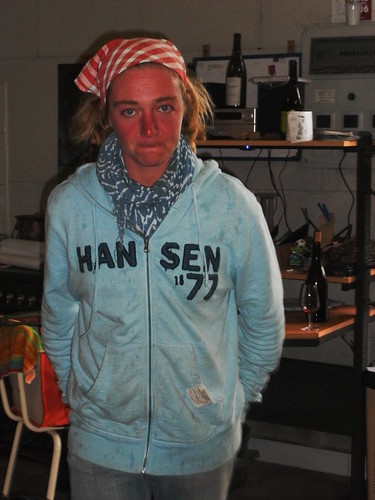
Julie Balagny
We went to meet Balagny at her winemaking facilities. She looked like the weather that day: stormy. And violently passionate. The first impression I got was of a woman bursting with energy, determined to make the best wine she can - and that we were intruding on that endeavour. But apparently I gave the right answers when she asked us about our wine preferences. I told I preferred the lighter, less ripe vintages in Beaujolais like 2008, 2010 and very possibly 2012 and wasn’t so keen on such over-ripe years as 2009. She jumped about ten meters into the air (I’m not lying!) and shouted “YEAHHHHHH!” (or was that a thunderclap?) and finally she smiled. From then on she was the sweetest host we had on the whole trip. First she took us to the barrels to taste the components of the 2012s. She has several different soils in her 3ha of Fleurie vineyards. I can’t remember the details of what soil type was which barrel, but all the barrel samples were simply exquisite. Perfumed, racy, energetic and far more lovable and ready than barrel samples elsewhere. These were samples that I would be very happy to drink now; ones that I wouldn’t need to make any excuses about e.g. being too young or reductive (though Balagny doesn’t yet want to bottle them because she feels they are a bit too reductive still). I can’t wait to have these bottled.
Then Balagny started opening bottles for us. First up was Fleurie La Carioca 2011. I loved the wine. Considering how I had just told her that I preferred the cooler vintages, I was afraid to tell her that this was awesome. But I plucked up the courage and she took it well. It did have ripe fruit, but it was also perfumed and racy, acidic and moreish. If all warm vintage wines were as refreshing as this I wouldn’t complain about hot years. I don’t object to sweet fruit; I object to flabbiness.

Fleurie Cayenne 2010 and Fleurie en Remont 2010 were some of the prettiest wines on this trip. Beautifully perfumed, peachy; racy, moreish, well structured but in no way harsh, sweetly fruity but with no excesses in any direction. They were so perfect that had we not had a couple more visits that afternoon I would have just sat down in some quiet corner and enjoyed the rest of these bottles all to myself. But then she opened a Fleurie Simone 2010. IIRC this was the cuvée from quartz soils and if anything, it is even prettier than those other Fleuries. Before this wine, I thought the idea that Cayenne was a “basic” wine was ludicrous. The only problem with these wines is that perfection was followed by perfection which was followed by perfection.
Balagny is a star. She’s the Foillard/Lapierre/Métras of the future.
About an hour into our visit to Balagny an environmental catastrophe on wheels arrived at her gates. Yvon Métras commands some of the highest prices of all Beaujolais. Considering his prices I was expecting someone driving a Lamborghini. Instead he took us a couple kilometers to his winery in a vehicle that in those few kms probably caused more harm to the environment than my flights from Hellsinki to Paris to Lyon to Amsterdam to Hellsinki combined!

Métras’ cellars were some of the wildest I’ve seen. There were chickens roaming about freely, there were bookcases with cartons of eggs in them, there was a suspicious looking leg of some animal or other hanging from the roof that made this carnivore almost become a vegetarian. I wouldn’t have been surprised if I had found dirty boxers somewhere.
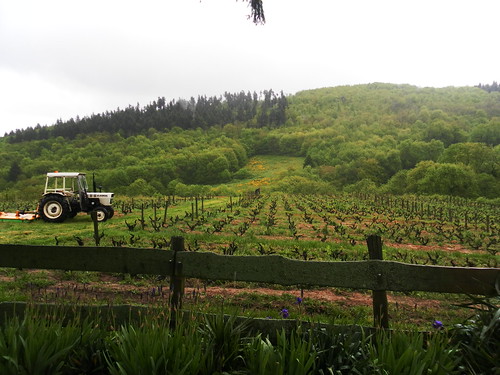
We went out to look at his vineyards (and if you can zoom into this picture, you can see that he does have a Lamborghini!). Métras, though perhaps commanding the highest prices of any producer in Beaujolais, has only 3ha which he works by hand. No machinery and no horses, everything is done by human hands.
Métras wasn’t the friendliest of people. He took us into his cellar. He crossed his arms and and looked disdainfully at us. “Why do you want to see Yvon Métras?” (Yes! He talked of himself in the 3rd person!).

I stammered that his wines are universally appreciated and that those who know of them speak of them in the same terms as of Foillard or Lapierre as some of the best wines in Beaujolais. He was not impressed.
He continued to be quiet but he did open up somewhat eventually. I asked about the history of “natural” wines and Jules Chauvet and finally he started to speak. Métras learned to make “natural” wine from Marcel Lapierre and he also knew Jules Chauvet. He showed us an empty bottle of a 1985 Chauvet Beaujolais (I forget which cru) that he had opened the previous evening. Apparently that wine was still in perfect condition - “natural” wine can age very well in good years. He said that Chauvet worked 50 years to make a technically and chemically stable wine “in the way that our grandfathers made wine”, but then when he finally perfected his technique, he died.
Fleurie 2011 – Considering what Métras’ cellars look like, I was expecting a dirty wine. Instead, the wine was squeaky clean and exquisitely pure. This wine is the opposite of the winery. And it is heartbreakingly beautiful.
Moulin-à-Vent 2011 – I must confess that M-a-V has generally been my least favorite Cru, but Métras’ was outstanding. I have usually found them impressive for their tannic structure and lack of charm. But this bottle was both tannic and charming. It also had a seductive perfume that I haven’t seen in most MaVs. It was pretty awesome. It was one of the best wines I tried on this trip.
Fleurie L’Ultime 2011 & 2009 – IIRC the L’ultime is the old vine cuvée. But even if I don’t remember correctly, this is pretty much the perfect wine. I know I have talked of 2011 and 2009 as being vintages that are too ripe and atypical for my tastes, yet these particular wines transcend my limitations. I love these two wines. Though both may be a bit on the heavy side, both are also fantastically refreshing and moreish. The 2009 is heavier, so I prefer the fresher 2011. But really, if you see either, just buy! These are some of the most perfect Beaujolais I have come across. Even Métras smiled after he had had these wines!

Tête was a winery I have only had one wine from before so it was exciting to visit them and try more. Unfortunately here I would have needed more French. But we got on somehow: I spoke superbad French, Michel and his wife spoke much better English.

Michel Tête / Domaine du Clos du Fief
Juliénas 2012 – a very pretty wine, lean fruit, racy structure and very refreshing.
St. Amour Les Capitans 2012 – really nice wine, perfumed, relatively light, well structured but not harsh at all, very refreshing. Very attractive.
Juliénas Cuvée Prestige 2011 – a sweet, very ripe wine; plenty of tannins, much fruit, but also good acidity. Hold and it will probably become something very nice.
Juliénas Cuvée Prestige 2006 – this was a nice treat: mature, and magnificently perfumed; soft palate initially, yet then it becomes quite firm on the finish. Refreshing. Great stuff.
St. Amour L’Exception 2009 – a freak year; and a freakish wine. All other Têtes were wonderfully refreshing but this one was heavy and ponderous and the only one of their wines that I didn’t want to drink huge amounts of.
From what I understood, they don’t use only autochthonous yeasts, but instead use a starter yeast of neutral aromas. Other than that they seem to be “natural” if I understood their French.
Mathieu Lapierre

On our last day we had a quick tasting at Lapierre. Mathieu has made wines since 2004 with Marcel and continues to make wine in that style. Mathieu had opened numerous bottles the previous day, so we got to try an exceptionally large amount of bottles – both sulfured and non-sulfured.
2012 – here the sulfur wasn’t noticeable and both cuvées were attractive; both were in a leaner style as expected of the year.
2011 – a much richer year and the non-sulfured cuvée was very fresh and vivid but the sulfured was only very nice and felt a bit tight.
2010 – here I didn’t see much difference between the sulfured and non-sulfured cuvées: both were bright and refreshing and savoury.
2009 – I must confess that though I usually like Lapierre, this vintage seemed a bit too raisiny and hot year in style for me.
2008 – sulfur isn’t always bad. In this vintage I thought the sulfured cuvée was much more fresh and lively than the non-sulfured one.
Cuvée Marcel Lapierre 2011 – a huge, massive, sweet and concentrated wine; yet with an amazing level of freshness and liveliness, too!
Cuvée Marcel Lapierre 2009 – raisiny. And I don’t like that. As in almost all wines on this trip, I preferred the “basic” wines to the fancy cuvées.
